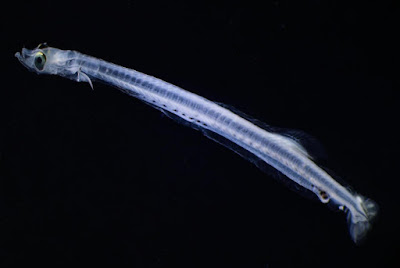ecologists explain to us how to prevent the environmental impact on a species
Climate change could affect the development of herring larvae,
However, the larval phase is a decisive period for the renewal of fish stocks.
The analysis of this phenomenon was carried out by Léa Joly, doctoral student in biology and ecology of fish larvae and Carolina Giraldo, researcher in marine ecology (both at the French Research Institute for the Exploitation of the Sea - Ifremer) .
The above larvae are Atlantic herring larvae, about one month old and averaging 2 centimeters. Like most fish larvae, they have a predominantly transparent body and are devoid of scales.
The larval phase is a decisive period for the renewal of fish stocks. During this period, mortality is very high, mainly due to predation (few individuals reaching adulthood).
It is especially during this stage that the body and organs of the fish develop, from the opening of the mouth to the development of all the fins. The larvae are therefore much more sensitive to changes in the environment in which they develop than adults. However, in a context of climate change, it becomes crucial to know whether the larvae are able to survive and develop correctly with regard to the different scenarios established by the scientific work of the IPCC (Intergovernmental Panel on Climate Change ) for the ocean in 2100.
An experimental “crèche”
In an attempt to answer this question, the larvae are reared in an experimental environment from birth until the end of the larval period (CoCKtAIL-IFREMER-AWI project). This means that the parameters of the environment (physical or biological) in which the larvae grow are controlled in order to be able to describe the precise effect of one or more combined parameters.
Here, the herring larvae are reared under so-called control conditions, which reflect the current environment, and under conditions where the temperature and acidity of the water are increased to mimic future ocean conditions. Rearing provides direct access to larvae and by comparing individuals according to their rearing environment, it is possible to understand the impacts of climate change on their physiology, development and survival rate.
This study focuses on a population of herring that reproduces in winter along the Normandy and Nord-Pas-de-Calais coasts and represents an important economic source. While herring are important to humans, they also have an essential place in the food web as they provide food for other fish, birds and marine mammals. The future of herring in the face of climate change therefore raises crucial ecological and socio-economic issues.
This analysis was written by Léa Joly, doctoral student in the biology and ecology of fish larvae and Carolina Giraldo, researcher in marine ecology (both at the French Research Institute for the Exploitation of the Sea - Ifremer).
The original article was published on The Conversation website.








0 تعليقات
You can share your ideas with us and display them on the site